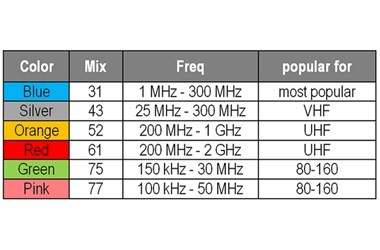Ferrites are made from oxides of iron, cobalt (Co), barium (Ba), and strontium (Sr). The type of ferrite most useful to hams are soft ferrites. (The hard ferrites are good for making magnets.) They are called “soft” because their magnetization can switch direction easily and without much loss. Ferrite’s most important property is its permeability (µ) at different frequencies. A material with high permeability has the ability to concentrate the available energy from a magnetic field. Magnetic energy is measured as magnetic flux which is itself a measure of the magnetic energy’s density.
Ferrites and iron both have high permeabilities and are used in the cores of inductors used at high frequencies. (The iron has to be powdered for use above audio frequencies.) Ferrite is generally the most popular choice for RF applications that require a high permeability.
A ferrite’s properties can be tailored to various frequency ranges and applications. Because each different type of material is made from specific combinations of oxides, it is referred to as a mix – for example, a Type 43 mix or a Type 75 mix. Fair-Rite (www.fair-rite.com) is a leading manufacturer of ferrites used in electronics, so the industry has more or less standardized on Fair-Rite’s mix designations.
There are two primary applications for ferrite in ham radio: inductors and EMI (electromagnetic interference) suppression. Ferrite for inductors and transformers store and release magnetic energy very efficiently. Ferrite for EMI suppression, though, the ferrite is designed to dissipate the magnetic energy as heat, just like a resistor. The equivalent circuit for a ferrite is shown in the following figure. jXS is the inductive reactance and RS is the resistance.

Many common types of ferrite can be used as either an inductor or a resistor — but in different frequency ranges! This is explained in detail by Fair-Rite’s application note, “How to Choose Ferrite Components for EMI Suppression,” and Fair-Rite also publishes a table of all their different ferrite mixes and intended uses. On the Fair-Rite home page, click on “Design Tools” then “Technical Tools & References” to find these and other useful documents.
A good example of a popular ferrite mix, type 43 ferrites exhibit mostly inductive reactance at low frequencies but are resistive at high frequencies. You can see this behavior in the graph below showing XL dominating below 10 MHz and RS above 25 MHz. A toroid core made of type 43 ferrite might make a great receive antenna transformer for 80 or 160 meters while it could soak up unwanted RF on 10 or 6 meters! In fact, the small beads molded into the coating of data cables are usually type 43 to prevent VHF and UHF signals from leaking out of digital devices. Table 1 gives the ranges for which ferrite mixes are best for EMI suppression.
Table 1 – Ferrite Mixes and EMI Suppression Range

Ferrite cores come in three basic styles: toroids (rings), beads (cylindrical sleeves), and snap-ons that clamp around a cable. Toroids have the advantage of having no ends so the inductor’s magnetic field stays almost completely within the core — good for avoiding unwanted coupling and leaking of signals. Beads are available from minuscule (they are even available in SMT packages) to fist-sized and have to be slipped over a wire or cable before connectors are put on or attached. Clamp-ons are useful for large cables, such as coaxial cable and power cords, and when a connector is already installed so a bead or toroid can’t be used. DX Engineering sells these parts individually or in combinations such as DXE-CSB31-COMBO (www.dxengineering.com/parts/dxe-csb31-combo) which is an assortment of clamp-on cores in different sizes.
So here you are at the hamfest and – what a deal! – a vendor has a big box of toroid cores labeled “Ferrite cores – 4/$1.” Sorry – walk on by. Unless they are marked with the mix used to make the cores, you have no idea how they will behave. You don’t really even know if they are ferrite or powdered iron. That’s why it’s so useful for DX Engineering to have added a paint stripe — it will identify the part exactly with no guessing.
Winding it up, so to speak, ferrite is an amazing material. It can be made to exhibit all sorts of different properties across a very wide frequency range. It can be an inductor or a transformer and it can also be a great little RF sponge to help keep RF in places where it should be and out of places where it shouldn’t be. Once you pick up that ferrite “know-how,” you’ll want to have it be part of your RF toolkit all the time.

